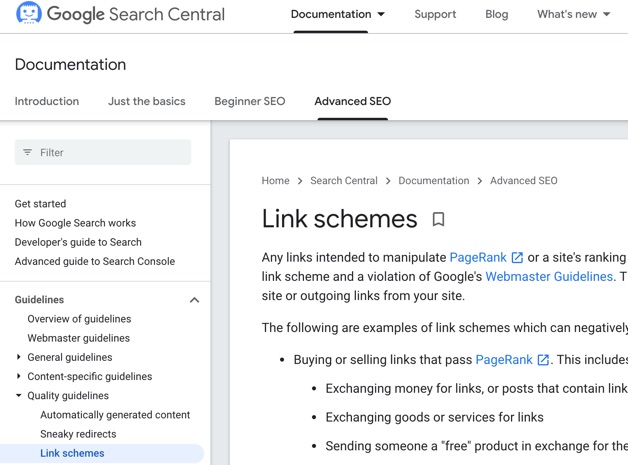Does guest blogging for SEO actually work?
If so, how does it actually help grow your search visibility?
And how do you get started and put guest blogging (a.k.a. guest posting) into action?
Whether you're looking to contribute guest posts to others, or are interested in accepting guest posts, the information below answers each of those questions in detail.
Let's dive in...
How Does Guest Blogging Work?
Guest blogging involves contributing blog posts to other blogs, in return for exposure to their audience.
And in return, a blog that accepts guest posts gets additional (and preferably unique) content to publish for free that takes just a fraction of the usual time to publish. Here's an example from SocialMediaExaminer:

Whether contributing or accepting posts, it's a win-win for both parties.
Guest blogging is a win-win relationship between the author and the blog. It can help SEO for both parties, plus multiple other benefits.Click To Post OnThe blog benefits from the additional content, using it to:
- Attract additional search engine traffic for the post itself.
- Increase their publishing frequency, growing their overall online visibility.
- Link to other posts, helping to increase rankings for those too.
- Help generate additional leads and, ultimately, revenue.
The contributor benefits from:
- Gaining exposure and name/brand recognition with a new (often much larger) audience, both directly through the blog, and other media such as email lists and social networks.
- When published on well-known, authoritative blogs, gaining credibility and authority.
- Gaining one or more links back to their website from an often more authoritative blog, attracting direct traffic and a potential ranking and traffic boost for their own website on search engines—though it should be noted that Google generally aims to discount this type of backlink.
- Attracting leads, either directly via a relevant opt-in offer, where permitted, in the bio box, or indirectly through visitors who click through and opt-in (including via remarketing ads).
Most blogs require their guest authors to submit unique content only. This helps to maximize the search engine traffic they attract as a result, which also benefits the author.
By guest blogging, you'll get back links that help Google understand what your own site is about while increasing your authority, all helping your SEO.Click To Post OnHow Does Guest Blogging Help Your SEO?
How Does It Help Your SEO As an Author?
In return for taking the time to create unique content for another site to publish, you will nearly always get at least one link back to your website.
This is usually via the author bio box, but may be supplemented by an additional link or two from the post itself too.
For example, here’s an author bio from cxl.com’s blog:

You’ll often be able to use keyword links (rather than straight URLs) which, done in the right way (see below), may help inform Google what the pages you are linking to are all about and help increase your rankings for relevant searches.
In addition, blogs you submit guest posts too will often be more authoritative (in terms of SEO) than your own blog.
This may help boost your own site’s authority on the search engines and increase search engine traffic in general.
However, while some SEOs still regard the technique as effective, Google's algorithms can discount the value of such links, so they probably shouldn't be relied upon as the basis of a high ranking.
How Does It Help Your SEO As a Blog Owner?
If you’re the owner of a blog looking to accept guest posts from others, your SEO benefits too.
For one, your blog gets an additional listing on search for the post, attracting new traffic.
In addition, you can edit the post so that relevant keywords are linked to other pages on your blog or website, helping Google to understand what that content is about and increase rankings.
With an increased amount of content—and more reason for visitors to stick around when they arrive from search—your blog also becomes more authoritative as a whole for the topics you cover, boosting your SEO and search engine traffic in general.
Finally, each new guest post is an additional opportunity for another site to link to you, again adding to your SEO while also providing direct click-through traffic.
How Do You Get Started Using Guest Blogging for SEO?
How Do You Get Started As an Author?
First, you need to ensure you’re adhering to Google’s guidelines for linking, in that your approach to guest blogging wouldn’t be regarded as a ‘link scheme’.

That means avoiding any approaches where you are submitting the same content to multiple blogs, using private blog networks, submitting to low quality sites, or approaching guest posting at scale.
In other words:
- Create content for the reader, not the search engines, just like you would (hopefully) do for your own blog.
- Keep it natural—approach suitable blogs on an individual basis, building a relationship with the owner or those responsible for it, so that you can potentially guest post more than once.
- Link back to your own site from the post in a natural way—don’t always use the same anchor text, link back to different places and use contextual links too (where words surrounding the link are keyword-rich, but the link itself might not be).
- Don’t make SEO or backlinks the sole purpose of guest posting—aim to add value for the reader and to the website you’re guest posting on, ensuring the content reflects positively on you and your business.
How to Find Guest Posting Opportunities
It has to be said, guest posting involves a lot of work, and not just creating the post itself.
Over time though, as you build relationships with blogs you can contribute to regularly, all the additional activity tends to get easier.
It also means that when reaching out to new potential blogs, you have more examples of your work to share. Blog owners are more likely to consider your proposals when they can see other authoritative blogs you’ve been published on.
The good news though is that there are lots of blogs out there that willingly accept guest posts from authors, and invite new authors to get in touch.
The process generally involves:
- Sending out cold emails to potential blogs.
- Following up with those that don’t respond to your first email.
Of course, only a certain percentage of those you reach out to you are likely to respond.
The success of your cold outreach campaign will depend on factors such as:
- The quality of your initial research—for example, only contact blogs that publish content like the type of content you want to create, who already accept guest posts from others, and who appear to have an active audience (such as via comments, on social media, or general industry recognition).
- The quality of the email you send and general approach—for example, I get regular emails from potential guest bloggers who address me by the wrong name, leave placeholders in the email (like ‘[sitename]’) or refer to a different website completely, and who often seem barely able to string a sentence together.
- Any relationship you already have with the blog owner—it helps if you can get some level of name recognition before your email ever drops in their inbox. This might be for example from comments left on their blog, interactions on social media and/or by joining their email list and responding to the odd email in a meaningful way.
- Where you are currently published—if you say publish content regularly on your own blog and provide examples of other authoritative blogs you’ve been published on, your campaign is likely to be a lot more successful than those who provide more limited references to their work.
Start finding blogs to approach as follows:
- Brainstorm for blogs in your industry that you’re already familiar with or know about—check their websites for information about guest posting opportunities, or look for evidence that they already publish content from guest authors.
- Search on Google for a relevant keyword or topic area combined with phrases such as “guest post guidelines”, “submit guest post”, guest authors” and so on.

- Look out for authors who write similar content to your own on third-party blogs—search on Google using their name and perhaps common keywords and phrases they tend to use in their bio to see where else they publish.
Create a spreadsheet where you can list all the potential blogs along with any initial submission information as part of this initial research.
Prepare Your Outreach Campaign
Start by researching all the blogs you’ve found more thoroughly.
You’re looking for information such as:
- What their guidelines are, if any, for publishing guest authors.
- The type of content they publish and that resonates best with their audience.
- How to contact them such as an email address or guest post inquiry form. If such a form is provided, use it in the first instance as it shows you’ve done your research, and they may just ignore inquiries made via other means.
- The name of who to contact so that you can address them personally. Ensure this is correct, or you’re unlikely to get very far!
You may also find at this stage that some of the blogs you thought might have been suitable no longer are. Don’t be afraid to cross a few off your list.
Before you start reaching out, look for opportunities to contribute to their community via other means first for say two or three weeks beforehand, such as by:
- Commenting on social media posts, engaging in other ways that help them (such as sharing posts with your own audience), or communicating with them directly (but without asking for anything).
- If they’re on YouTube, watching out for new videos in order to leave positive comments and appreciation for their content (but be genuine about it!)
- Similarly, for new blog posts, aim to leave comments on the post if commenting is enabled and do things like share the content on social, tagging the blog owner.
This is all so that when your email arrives in your inbox, it may trigger some (probably vague) sense of recognition and help get your email opened and your proposal considered.
Start Contacting the Blogs On Your List
It’s finally time to start contacting the list of blogs you’ve done all the research about and preparation for.
Here are some guidelines to follow:
- Avoid “cookie cutter” emails—lots of the guest post proposal emails I receive start the same kind of way with lines such as I love your blog… or I’m a regular reader… followed by something that makes it clear they really aren’t (such as the name of a different blog entirely!). Don’t be fake—blog owners can smell it a mile off and won’t respond to you.
- Personalize your emails—reach out to the blog owner on a personal level so it’s clear you’ve done your research and are speaking directly to them.
- Write well—take the time to craft the email you send so it reads well. Don’t forget it’s the first impression someone will get as to how well you actually write.
- Follow their guidelines—for blogs that have published guest posting guidelines, follow them meticulously for how they prefer you to get in touch with them. If you can’t follow basic instructions, it’s unlikely blog owners will want to work with you.
- Provide examples of where else you have been published—to consider you, they’ll want to see examples of your work, so provide some links. If you’ve been previously published by some well-known blogs, even better, as it reduces the risk for them and multiplies your credibility.
- Keep a record of when you have been in touch, and schedule when to contact them again to follow up.
- Follow up! If you only send one email, you’ll be disappointed. Most responses will come from your repeated follow-ups. Avoid becoming a pest, but follow up with further emails 3-5 times. Send your first follow up the day after, but then gradually increase the number of days between your emails. If they still don’t respond after several attempts, it’s likely they’re simply not interested.
How Do You Get Started As a Blog Owner?
As your blog grows, you’ll likely receive a continuous stream of inquiries from people who can potentially contribute to your blog via guest posting.
Rather than just accept anyone, in order for guest posting to have a positive effect on your SEO, you need to ensure the right level of:
- Quality in the content you publish.
- Alignment with the topic areas that your blog focuses on.
For these reasons, and to help you filter incoming guest posting requests, it’s good practice to develop a set of guidelines and policies, potentially published on your blog, that you follow.
For example, HubSpot has four main blogs, each with their own set of guest blogging guidelines.

Your guidelines should cover requirements such as:
- Giving you permission to edit content as needed once provided to you, such as for SEO purposes (covered more below).
- The need for authors to submit unique content only, so that the content and your blog as a whole achieves maximum rankings.
- Whether or not you’re happy for authors to publish the same content elsewhere after publication on your blog, and after what time frame. If you do decide to permit this, it’s best to leave a period of at least a few months so your blog is recognized as the primary source of the content for SEO purposes.
You might also consider developing a specific application process for those interested in guest posting on your blog to follow that you can then point people to.
The result will be a smaller number of applicants that can then be more easily processed, who are:
- Likely to be more serious about contributing quality content that benefits your blog and your SEO.
- Able to follow instructions.
- Easier to work with.
For suitable applicants, you can then set them up with separate accounts within your WordPress dashboard.

When you do so, rather than selecting the Author role, which would allow them to both enter posts and directly publish them, select Contributor.

That means they can “write and manage their own posts but cannot publish them”.
You’ll likely want to ensure too that each author can enter some bio information, including say a link back to their website, to be displayed alongside the post. Here are some different ways you can achieve that.
Once they’ve added a new post to your blog as a draft, you or someone on your team then needs to be able to:
- Review the content—it’s vital for good SEO to ensure this includes checking that the content is unique and not published elsewhere.
- Edit it as required (authors should agree to you doing this prior to acceptance).
- Schedule the post for publication in line with your content calendar:
In editing the article, this includes making some enhancements for SEO purposes, including:
- Linking to other posts on your blog via relevant keywords, either directly linking the keywords or where the keywords are in the surrounding text.
- Enhancing the post itself so it ranks well, such as via the Yoast SEO plugin and adding alt text to images that include relevant keywords.
After it’s published, it’s a good idea to also look for two or three opportunities on your blog where you can link back to the new post from existing posts via relevant keywords, helping it to rank quickly for relevant searches.
Depending on your guidelines and the agreement you have with authors, in order to maximize the SEO value of the post, you likely want to also periodically check the content has not been subsequently published elsewhere within a reasonable time frame after publication on your blog.
Frequently Asked Questions
Does guest blogging for SEO actually work?
Yes, guest blogging benefits both the author and the blog by increasing search engine traffic, authority, and link opportunities.
How does guest blogging help your SEO as an author?
It helps by providing backlinks to your website, improving authority, and potentially increasing rankings and search engine traffic.
How do you get started using guest blogging for SEO?
Start by researching quality blogs, personalizing outreach emails, and building relationships with potential hosts for guest posting opportunities.
To Conclude
Whether you’re considering submitting guest posts as an author, or wondering how it all works as a blog owner, you now know exactly how to approach guest blogging for SEO.
Of course, don’t forget the other benefits of guest blogging too, including increased authority, brand recognition and lead flow.
These benefits, alongside SEO, apply to both sides of the guest blogging relationship, a key reason why the practice remains an important and much-used content marketing strategy.




